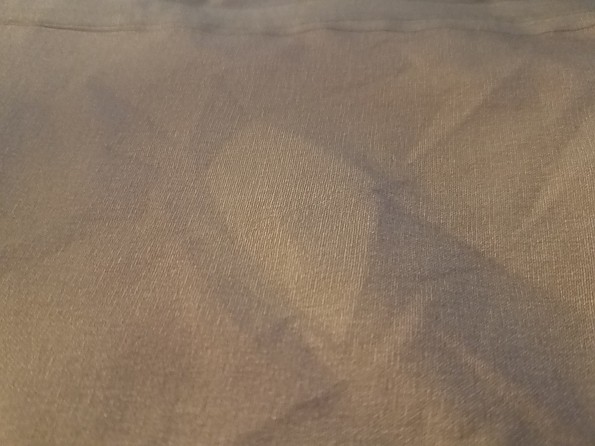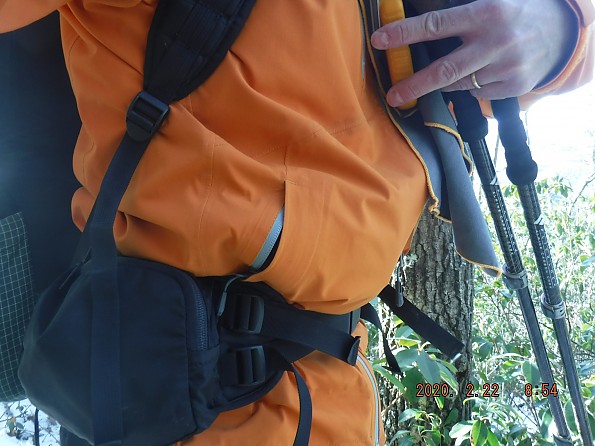Outdoor Research Microgravity Jacket

The Outdoor Research Microgravity Jacket attempts to bridge the gap between hard and soft shell, and I think it succeeds for the most part. Decently weatherproof and almost unbelievably breathable, it feels soft on the skin, doesn’t leave me clammy, stretches without constraining, and is silent compared to most other outer shells. It is definitely my favorite shell to date, but be warned if you stand around in the rain and don’t work it off, you will get damp.
A few minor negatives...fiddly hood adjustment, pocket position, no pit zips (although I’m not sure you need them!), and some minor leakage at the zippers. Some folks don't like the hood (designed more for helmets), but it didn't bother me.
Pros
- Almost unbelievable breathability
- Waterproof for most weather systems
- Extremely comfortable
- Almost silent
- Great fit
- Easy to layer
- Flexible stretch material
Cons
- Not “monsoon” waterproof
- Hood bill could be a little longer
- Side hood adjustment hidden/fiddly
- Hood fit may not be for everyone
- Minor leaks at zippers
- Unclear info online regarding DWR
- No pit zips for ultimate venting
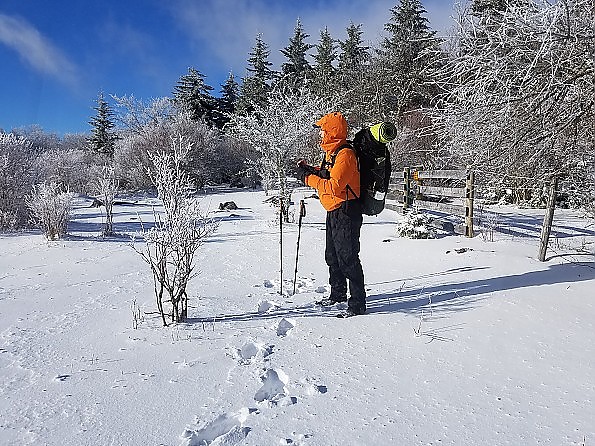 OR’s latest three-layer jacket with AscentShell electrospun membrane technology, the Microgravity, is made for active alpine pursuits.
OR’s latest three-layer jacket with AscentShell electrospun membrane technology, the Microgravity, is made for active alpine pursuits.
The design is supposed to balance weather resistance with breathability and flexibility for activities like hiking, climbing, skiing, and other fun adventures. Note that even OR recommends a different jacket if you are going to be standing in the rain for days:
“Bottom line: AscentShell is best for people who want a stretchy, waterproof jacket that is extremely comfortable to wear during high-exertion activities, but it isn’t great for burly monsoon conditions or instances where you’re standing still in a downpour.”
My interpretation...it is designed for snow and rain showers but will probably wet out in steady long rains. Its breathability/air permeability means it dries quickly and keeps you warm. 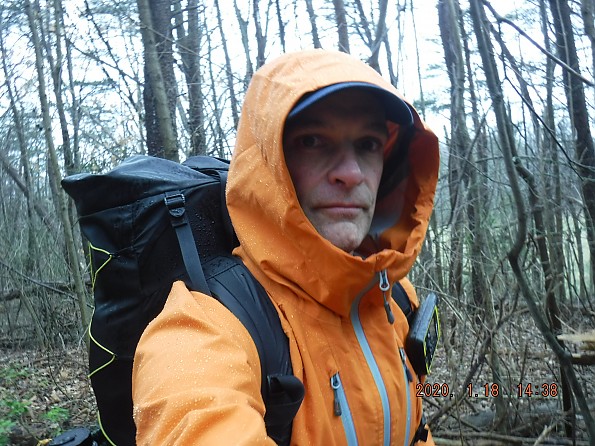 I have found both these to be true although haven’t been “lucky” enough to have multiple long days of rain on any of my test trips after six months. I have tested in some heavier rainstorms for an hour or two with decent results (see below for more details).
I have found both these to be true although haven’t been “lucky” enough to have multiple long days of rain on any of my test trips after six months. I have tested in some heavier rainstorms for an hour or two with decent results (see below for more details).
Will this jacket keep me absolutely dry in extended rain? Probably not. Will any jacket I have owned do that? No, because I usually work up a sweat or they just don’t breathe that well in constant rain. The Microgravity keeps me relatively dry, breathes better than any outer shell jacket I have owned, and therefore dries me out faster than any other option that I am aware of. I agree with OR that multiple days of constant rain would lead me to another choice such as a Gore-Tex-based jacket, but those never seem to work for me when I am exerting myself climbing hills.
Now on to the details...
Fit: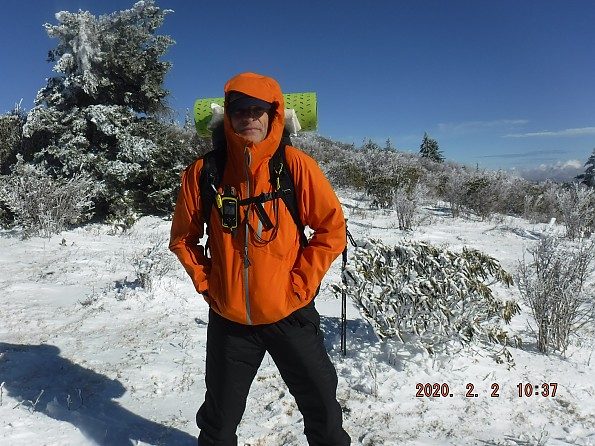 OR sizing showed me (6'0"/ 183 cm, 170 lbs/77 kg) as a large and that worked really well. Size ranges are available for men (S-XXL) and women (XS-XL).
OR sizing showed me (6'0"/ 183 cm, 170 lbs/77 kg) as a large and that worked really well. Size ranges are available for men (S-XXL) and women (XS-XL).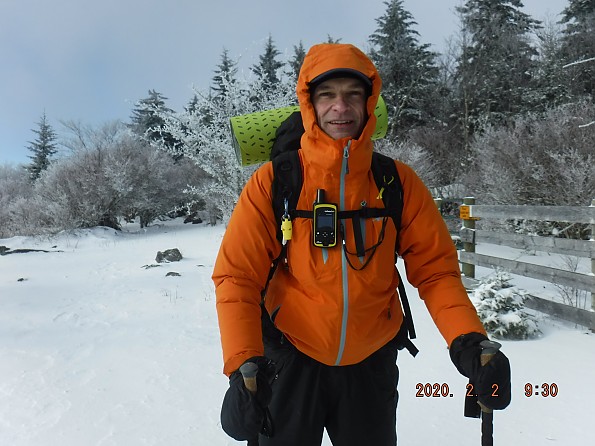 The jacket is a relatively slim fit without bagginess, but still allows for room underneath (see layering below). In the photo above I have a base layer, light fleece, and synthetic puffy on underneath. It may be a bit tight for different body styles so just pay attention to the size chart which seems to be accurate.
The jacket is a relatively slim fit without bagginess, but still allows for room underneath (see layering below). In the photo above I have a base layer, light fleece, and synthetic puffy on underneath. It may be a bit tight for different body styles so just pay attention to the size chart which seems to be accurate. 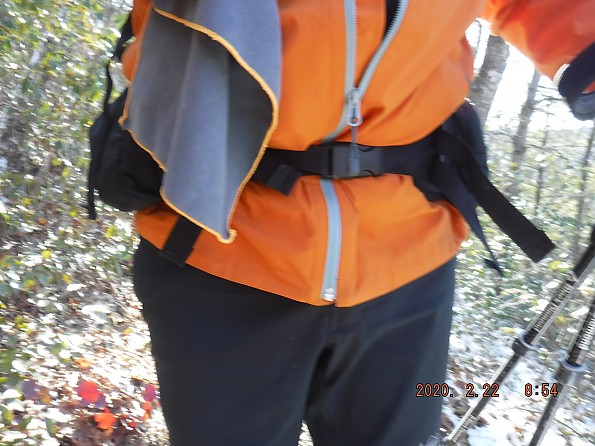 The torso comes down just far enough below my waist, but not so far as to get in the way.
The torso comes down just far enough below my waist, but not so far as to get in the way.
 The arm length was good for me—over the wrist cuffs that adjust well enough with the hook/loop closure. The photo above includes a pair of eVent rain mitts over fleece gloves—this fit just fine under the sleeve.
The arm length was good for me—over the wrist cuffs that adjust well enough with the hook/loop closure. The photo above includes a pair of eVent rain mitts over fleece gloves—this fit just fine under the sleeve.
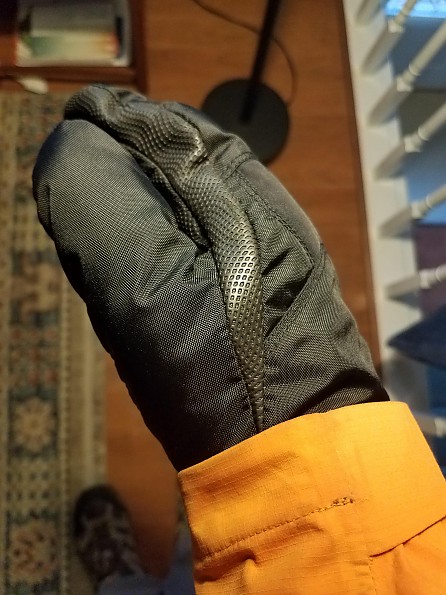 I don't wear much heavier than this while moving but took this shot of the Microgravity over my heavier mitts I wear around camp.
I don't wear much heavier than this while moving but took this shot of the Microgravity over my heavier mitts I wear around camp.
 The hood is loose enough to allow air flow, and can be tightened in three directions...speaking of which...
The hood is loose enough to allow air flow, and can be tightened in three directions...speaking of which...
Adjustability:
The hood adjusts from the sides and back and adapts to helmets.  The side adjustment is through a hidden cord lock (where I am pointing above) within the rim of the hood on either side. I found this OK but a bit finicky to find with gloves on. Maybe it’s just me, but I like to see the cord lock that I am using to adjust things.
The side adjustment is through a hidden cord lock (where I am pointing above) within the rim of the hood on either side. I found this OK but a bit finicky to find with gloves on. Maybe it’s just me, but I like to see the cord lock that I am using to adjust things.
 The hood closure in the back was fine—although seldom adjusted once I found my sweet spot as I don’t have a helmet and like to leave hoods as wide as possible for air flow. Another review by Brian Vinci brought up a good viewpoint on the hood—how it can block views when you turn your head. I did not notice this as much due to the fact that I wear a trail runner cap about 90 percent of the time I wear a shell. The bill of the cap doesn't allow that to happen:
The hood closure in the back was fine—although seldom adjusted once I found my sweet spot as I don’t have a helmet and like to leave hoods as wide as possible for air flow. Another review by Brian Vinci brought up a good viewpoint on the hood—how it can block views when you turn your head. I did not notice this as much due to the fact that I wear a trail runner cap about 90 percent of the time I wear a shell. The bill of the cap doesn't allow that to happen: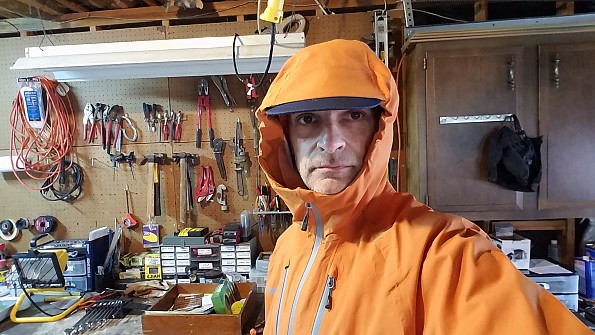 I also tend to wear a shell wide open for venting as much as possible, which allows a better range of view:
I also tend to wear a shell wide open for venting as much as possible, which allows a better range of view: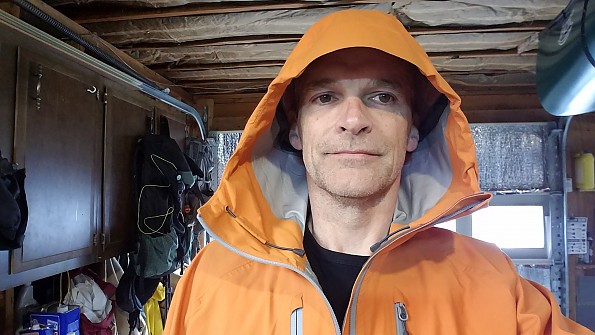 But, if you zip up without tightening the sides then looking sideways does get partially blocked:
But, if you zip up without tightening the sides then looking sideways does get partially blocked: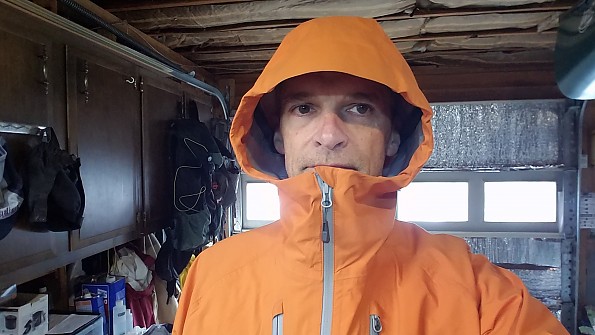
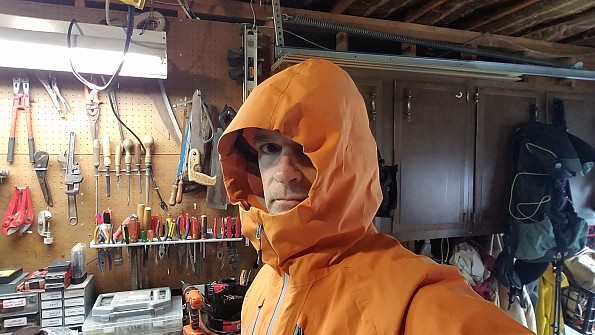
However, I found when the sides are tightened this doesn't happen:
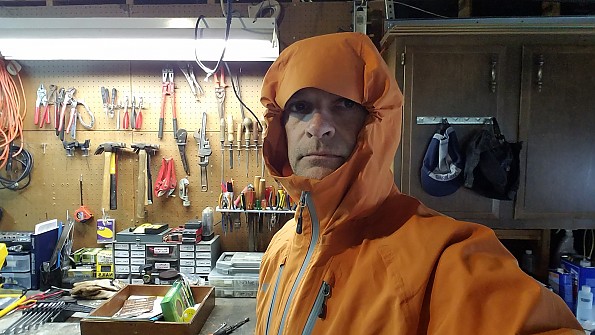
On the comfort issue, I found if you want it cinched to head versus helmet size you need to find your sweet spot—mine being the back only about half tightened: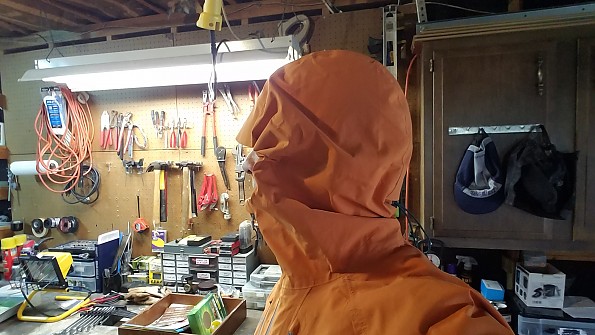 but tighter than that and I did feel the cords. The fit may not be the same for everyone obviously, and my giant head might bias this.
but tighter than that and I did feel the cords. The fit may not be the same for everyone obviously, and my giant head might bias this. As with most outer shells, I feel the bill of the hood could be a bit longer.
As with most outer shells, I feel the bill of the hood could be a bit longer.
 Without my Trailspace Cap, and the collar open for venting, rain did spatter a bit around the open collar. This didn't happen with my cap on. Obviously here I am talking about mostly vertical rain...walking into a driving rain I wouldn't have it open like this.
Without my Trailspace Cap, and the collar open for venting, rain did spatter a bit around the open collar. This didn't happen with my cap on. Obviously here I am talking about mostly vertical rain...walking into a driving rain I wouldn't have it open like this.
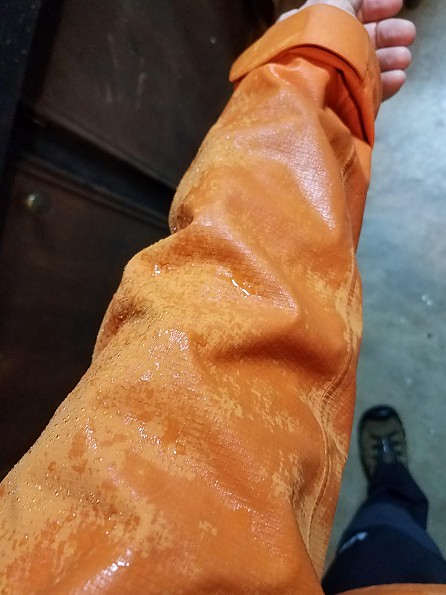 The cuffs were adjustable with a hook/loop closure, but I tended not to tighten them up as I either wore it over gloves or left it loose to vent a bit more.
The cuffs were adjustable with a hook/loop closure, but I tended not to tighten them up as I either wore it over gloves or left it loose to vent a bit more.

The waist cinch in the back seems fine, but I honestly didn’t use it at all as the length is good enough and the trim fit keeps it from flapping around; if I was wearing this jacket I was moving so didn’t tighten up the waist.
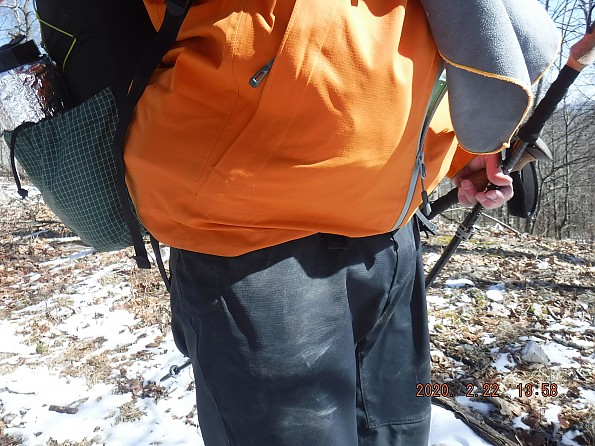 It is a slim fit, so the waist slips over my hip belt pockets (ULA Ohm 2.0) well, but if these large pockets are stuffed full of snacks like this, it is a tight fit.
It is a slim fit, so the waist slips over my hip belt pockets (ULA Ohm 2.0) well, but if these large pockets are stuffed full of snacks like this, it is a tight fit.
Comfort:
Comfort is where the Microgravity really shines. It is by far the most comfortable outer shell I have ever owned. The fabric inside and out is soft to the touch and feels great against the skin.
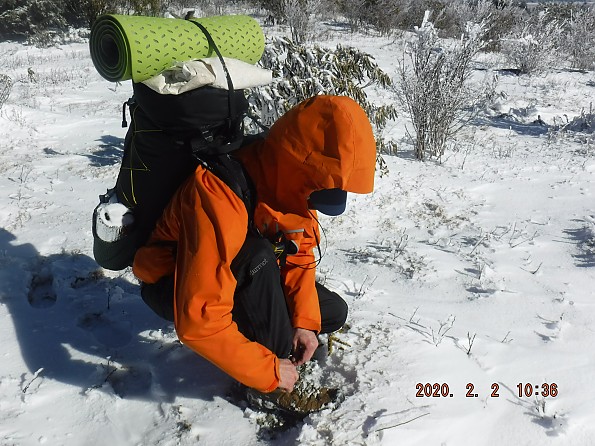 It flexes and stretches with you really well be it clambering over logs or bending down to tie an errant shoelace (tied poorly on a sub 20°F morning).
It flexes and stretches with you really well be it clambering over logs or bending down to tie an errant shoelace (tied poorly on a sub 20°F morning).
I felt no friction anywhere or tightness doing normal hiking activities. The stretch fabric really works well.
Water Resistance:
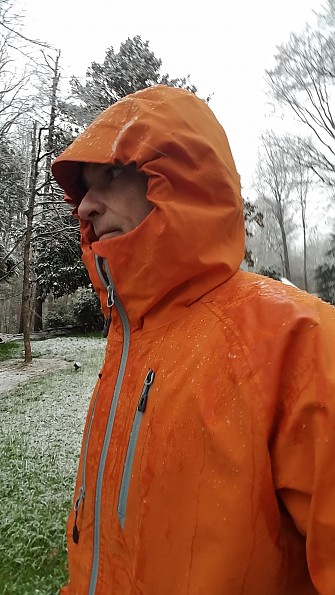 To date, the Microgravity is pretty weather resistant and lives up to the somewhat qualified expectations set by OR.
To date, the Microgravity is pretty weather resistant and lives up to the somewhat qualified expectations set by OR.
 I have had it out in snow and rain on multiple occasions. Again, note OR’s recommendation that this is not a jacket for standing around in monsoons, but is for active pursuits. So they are saying be ready to get a little damp in heavier or more constant rain, but dry off quickly.
I have had it out in snow and rain on multiple occasions. Again, note OR’s recommendation that this is not a jacket for standing around in monsoons, but is for active pursuits. So they are saying be ready to get a little damp in heavier or more constant rain, but dry off quickly.
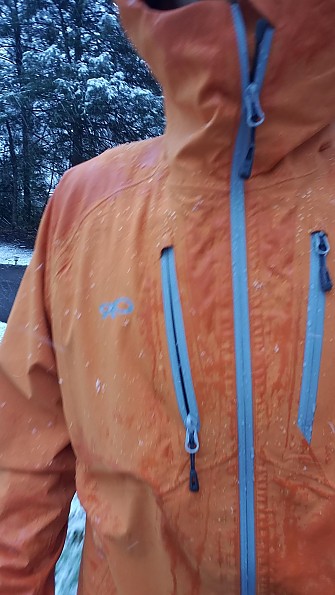 Several hikes in snow showed that the Microgravity holds up well to frozen precip—not a bit of moisture getting through.
Several hikes in snow showed that the Microgravity holds up well to frozen precip—not a bit of moisture getting through.
 One weekend trip I had a full day of wet steady snow, with highs in the 30s (F). No issues that trip at all. The snow melting on the jacket did not seep through.
One weekend trip I had a full day of wet steady snow, with highs in the 30s (F). No issues that trip at all. The snow melting on the jacket did not seep through.
 I have been on five backpacking trips and numerous hikes and local walks with the Microgravity in wet weather. So far it has held up to up to two hours of steady rain.
I have been on five backpacking trips and numerous hikes and local walks with the Microgravity in wet weather. So far it has held up to up to two hours of steady rain.
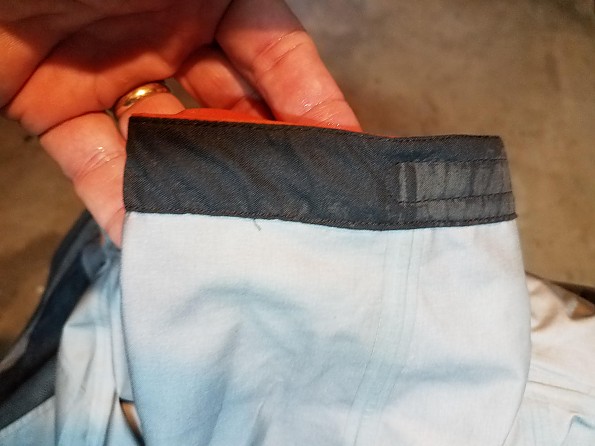 I did find the cuffs getting a bit damp in a two-hour steady rain, but that may have been me letting them be too loose over my gloves.
I did find the cuffs getting a bit damp in a two-hour steady rain, but that may have been me letting them be too loose over my gloves.
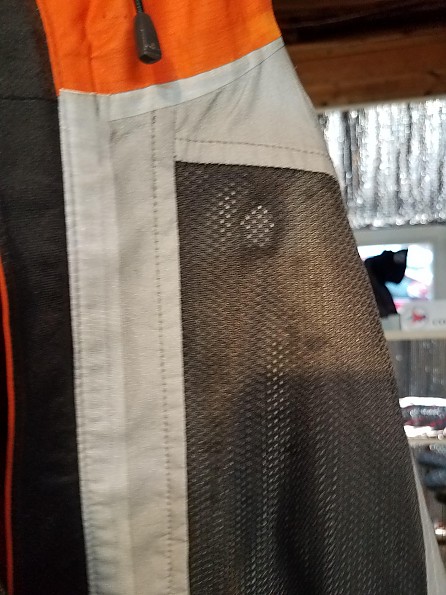 Also I noticed some moisture inside the chest pocket after a couple of rainy hikes. This may be a zipper waterproofing issue like I mention below for the main zipper.
Also I noticed some moisture inside the chest pocket after a couple of rainy hikes. This may be a zipper waterproofing issue like I mention below for the main zipper.
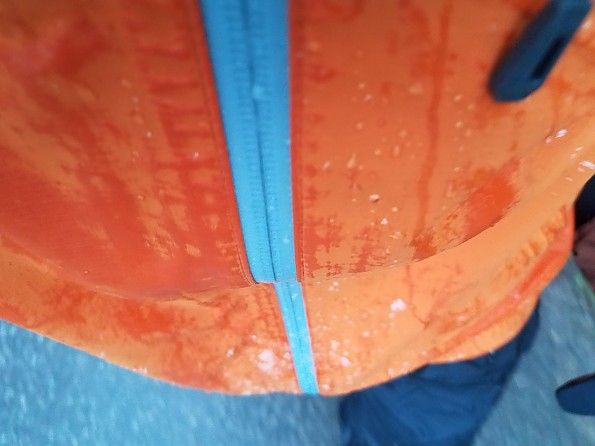 The AscentShell membrane seems to “dampen” faster on the outside rather than stay beaded up. Here is an example. I am not sure if this is a result of the DWR or the way the jacket is made. However, nothing seems to get through to the inside except through the zipper pocket and the main zipper in spots (see below).
The AscentShell membrane seems to “dampen” faster on the outside rather than stay beaded up. Here is an example. I am not sure if this is a result of the DWR or the way the jacket is made. However, nothing seems to get through to the inside except through the zipper pocket and the main zipper in spots (see below).
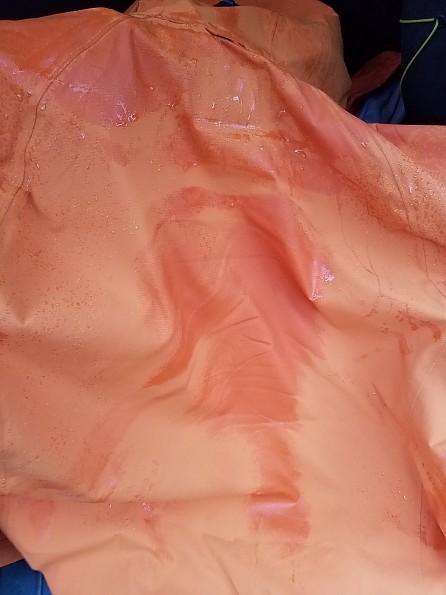 After a backpacking trip in steady rain, the outside under my pack is wet, but...
After a backpacking trip in steady rain, the outside under my pack is wet, but...
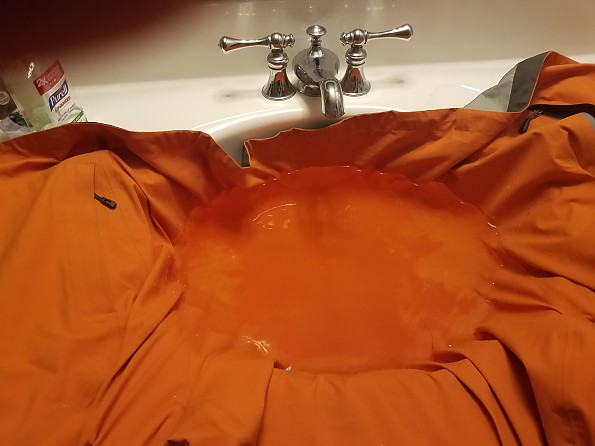 As a lab test, I filled a dry sink lined with the Microgravity and let it sit for five minutes. At that time, there was some dampness in the sink, but that could have been from condensation as I used cold water.
As a lab test, I filled a dry sink lined with the Microgravity and let it sit for five minutes. At that time, there was some dampness in the sink, but that could have been from condensation as I used cold water.
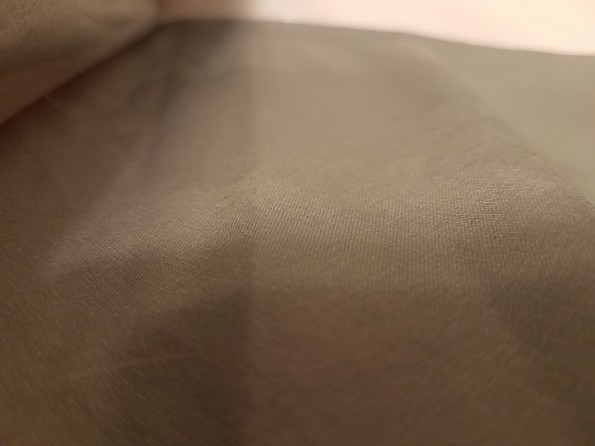 The Microgravity did seem to wet through a bit under this amount of water, but I am not sure what that would equate to in real rainfall. I don’t plan on sitting in a lake or stream with this jacket on.
The Microgravity did seem to wet through a bit under this amount of water, but I am not sure what that would equate to in real rainfall. I don’t plan on sitting in a lake or stream with this jacket on.
The DWR seems to have held up after several months of use—no real change, but the last couple of months I have not been able to get out in the rain much due to the shelter-at-home policies of my state and the local National Forest closing trailheads and not allowing dispersed camping. Local tests in spring storms in the Carolinas have yielded mostly good results with one exception.
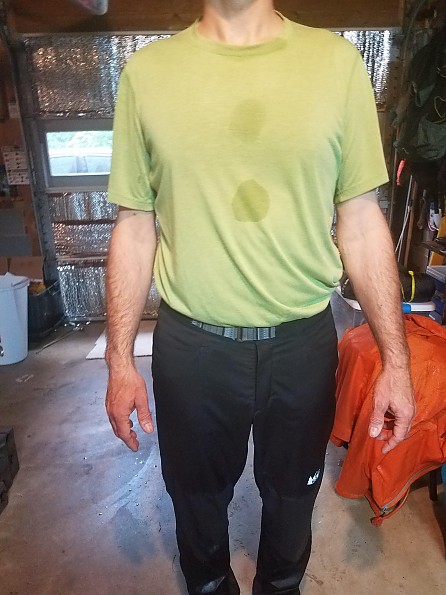 After a 1.5-hour walk in steady rain in 60-degree weather, I found myself relatively dry, but a couple of spots behind the front zipper were damp. This could be sweat, but I doubt it as it only occurred right along the zipper, so I am a bit concerned about the durability of the waterproofing there. Previous walks and trips didn't show that.
After a 1.5-hour walk in steady rain in 60-degree weather, I found myself relatively dry, but a couple of spots behind the front zipper were damp. This could be sweat, but I doubt it as it only occurred right along the zipper, so I am a bit concerned about the durability of the waterproofing there. Previous walks and trips didn't show that.
It should be noted here that the OR description of the Microgravity and the AscentShell membrane doesn’t mention DWR treatment. On top of this, the suggestion that it is not made for standing around in the rain suggests that maybe it doesn’t have DWR. Trailspace checked with OR and confirmed that this jacket does have DWR treatment.
Breathability:
Well, this is where the Microgravity really shines. I call it close to unbelievable. I sweat a lot even below freezing, and this jacket has allowed me to dry out faster than anything else I own. OR discusses this as not just breathability, but air permeability—it allows moisture to escape well before you need it to.
This excellent breathability or air permeability means it may be a little less wind resistant than a pure wind shirt/jacket, but it does the job well enough for me.
I tend to wear it down to around 40°F with just a t-shirt underneath and it is a good balance of shielding the wind while not making me sweat too profusely. 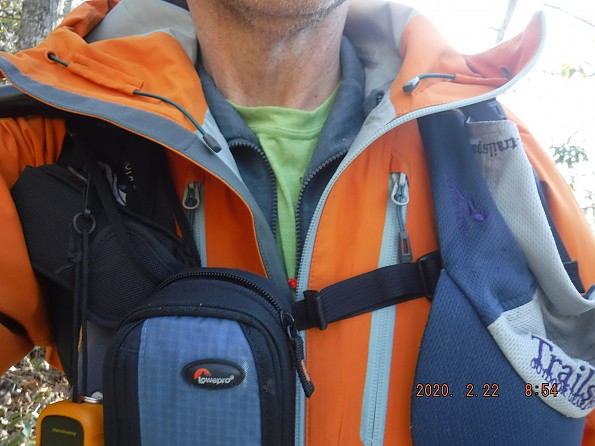 Below that I add a light fleece. Unless it's blowing sideways precip, I leave the collar open a good amount to assist in venting my high metabolism.
Below that I add a light fleece. Unless it's blowing sideways precip, I leave the collar open a good amount to assist in venting my high metabolism.
This breathability comes with a slight cost in wind resistance (see below).
Working hard I can still build up a sweat, but the Microgravity takes care of that in no time, speaking of which...
Moisture:
No jacket I have owned has dried me out as quickly once I stopped sweating as the Microgravity. Several trips I built up quite a sweat in either just a T-shirt or my fleece as well. In each case the Microgravity kept me warm and allowed the clothes to dry out quickly when I dialed it back a bit.

I still miss pit zips, which I understand from OR would take away from the flexibility of the jacket’s “Dynamic Reach” underarm panels, but, wow, combined with the air permeability of this baby, pit zips might mean I never sweat again!
 The pockets are mesh on the inside so in good weather where the Microgravity is just being used as a wind jacket, they provide extra venting.
The pockets are mesh on the inside so in good weather where the Microgravity is just being used as a wind jacket, they provide extra venting.
In testing during all sorts of conditions, I did manage to get wet at times but each time the Microgravity dried me out well.
Warmth:
This jacket has helped to keep me warm in sub-freezing temperatures down to the high teens (degrees F). Below 40°F I usually wore a Merino wool T, Rab light fleece, and the Microgravity. I still heated up walking up hills, but it was manageable and dried/cooled fast at the top. I haven’t had it out in below zero degrees (F) temps so can’t speak to that but feel it would still allow room for layering.
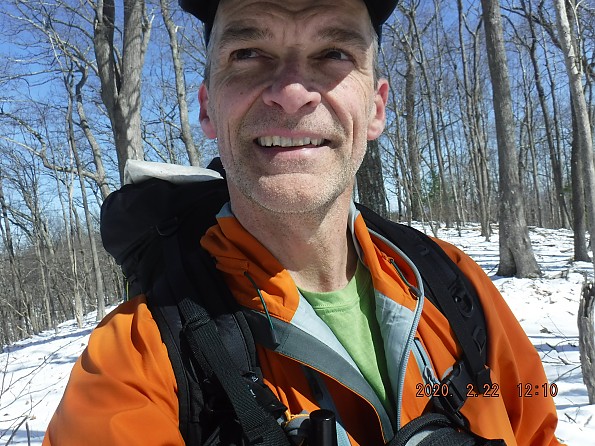 Over 40°F usually found me in this jacket with a tee only. It feels great on the skin and keeps sweat from building up. And when I am working hard, even the 30°F temps let me use it just with a tee.
Over 40°F usually found me in this jacket with a tee only. It feels great on the skin and keeps sweat from building up. And when I am working hard, even the 30°F temps let me use it just with a tee.
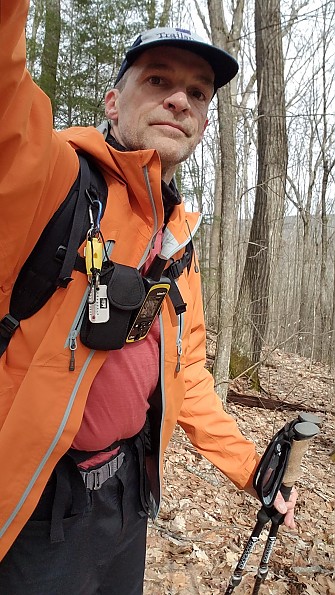 Since my initial review, I have managed to take it out in temperatures up to the mid 70s (F). In those conditions I still didn't build up a lot of moisture, but your mileage may vary. I feel like anything above the 70s, for me, would be too warm for this jacket as summer showers and storms in the southeastern US with temps in the 80s or 90s wouldn't warrant bringing such a heavy duty layer. For much less weight in warm weather, I could carry a windshirt and a light rain jacket and alternate those to conditions.
Since my initial review, I have managed to take it out in temperatures up to the mid 70s (F). In those conditions I still didn't build up a lot of moisture, but your mileage may vary. I feel like anything above the 70s, for me, would be too warm for this jacket as summer showers and storms in the southeastern US with temps in the 80s or 90s wouldn't warrant bringing such a heavy duty layer. For much less weight in warm weather, I could carry a windshirt and a light rain jacket and alternate those to conditions.
Wind Resistance: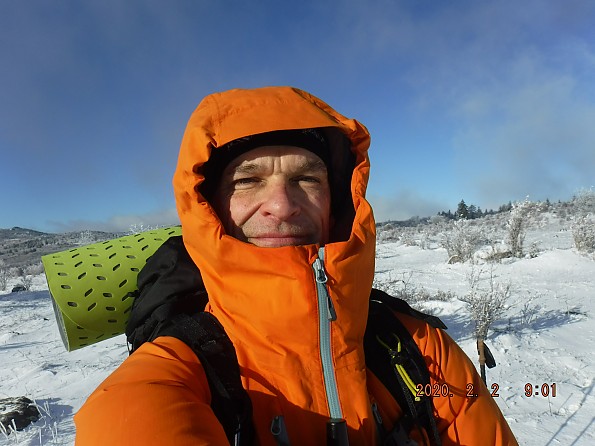 I expected to get less wind resistance than the Microgravity provides due to the excellent air permeability. However, I have been completely comfortable in mid-20s with 30 mph gusts with just this and a fleece over my usual T-shirt or baselayer. Above 30 mph winds, and just a T-shirt on, you can feel the breeze, but it is not uncomfortable to me. I have left my ubiquitous wind shirt/jackets at home since this test began until temps got above the 70s (F) and the Microgravity was overkill, in my opinion.
I expected to get less wind resistance than the Microgravity provides due to the excellent air permeability. However, I have been completely comfortable in mid-20s with 30 mph gusts with just this and a fleece over my usual T-shirt or baselayer. Above 30 mph winds, and just a T-shirt on, you can feel the breeze, but it is not uncomfortable to me. I have left my ubiquitous wind shirt/jackets at home since this test began until temps got above the 70s (F) and the Microgravity was overkill, in my opinion.
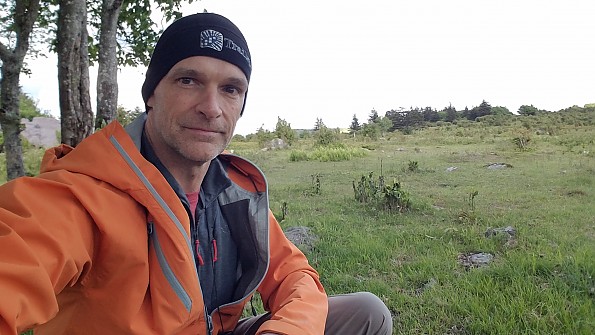
Here I am at a windy camp (sustained 10-20+ mph) with temperatures hovering in the 60s (F) and I was feeling a bit chilled even with a fleece on. I threw on the Microgravity and it sheltered me well enough and kept me warm.
Layering:
So far I have tested the Microgravity as part of several layer systems as follows:
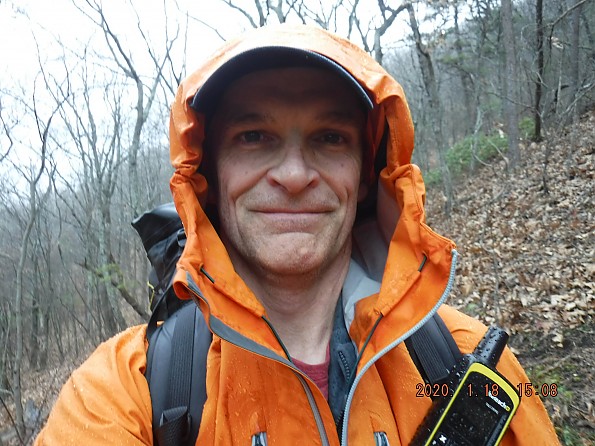 Merino wool or poly T-shirt, Rab light fleece, and Microgravity
Merino wool or poly T-shirt, Rab light fleece, and Microgravity
Merino wool or poly T-shirt and Microgravity (see photo in previous section).
 Merino wool T-shirt, synthetic puffy, and Microgravity
Merino wool T-shirt, synthetic puffy, and Microgravity
The latter didn’t last long—just warmed me up the first 30 minutes of a really cold (15 degree F) morning. The puffy fit well underneath everything. Although I haven’t been in really cold temps (lowest was around 10°F) I still had lots of room and flexibility for a base layer instead of the T-shirt if needed.
The cuff length is good and fits over my rain mitt/fleece glove combo, which is about the thickest wrist covering I use.
Features:
The main feature of this jacket is the fabric—AscentShell. According to OR's website, it’s a combination of 100 percent Nylon 20Dx45D mechanical stretch ripstop, with 100 percent polyester 30D backing. 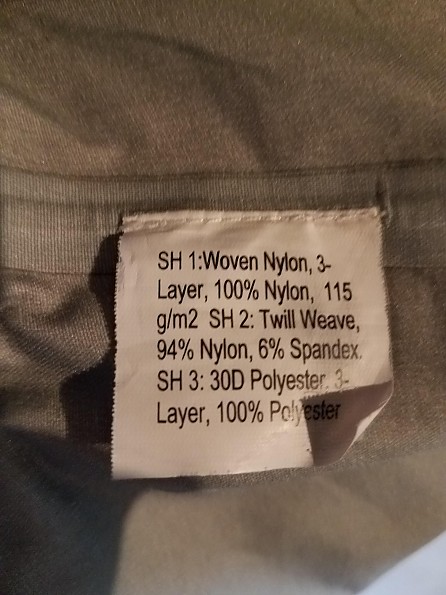 The label shows slightly more detail on the middle layer of this three-layer jacket construction.
The label shows slightly more detail on the middle layer of this three-layer jacket construction.
I won’t go into excruciating detail here but will provide this OR link to the description of the material and how it works.
This is not your typical rain jacket. The fabric feels more like a piece of clothing than a shell.
Here are some closeups of the inside:
As mentioned above I find it very comfortable with just a T-shirt under it down to about freezing. There is also minimal noise to it, which allows you to wear it more than just in snow and rain.
Excuse the rattling of doodads in this video, as well as the wind, but notice the lack of swishing sound that you usually find in an outer shell.

The Microgravity packs into its own pocket with a hook to hang it on a carabiner for climbers. It measures approximately 8 by 7 inches. I tried stuffing it like this at home so I could weigh it, but like most jackets with this feature I find it a pain and tend to just roll or stuff it into an outer pocket of the pack for easy access.
 Pockets are typical chest and waist...so let’s discuss...
Pockets are typical chest and waist...so let’s discuss...
Function:
The biggest design issue I have with the Microgravity is pocket position. It may work for other types of activities, but especially for backpacking the pockets seem to conflict with my...
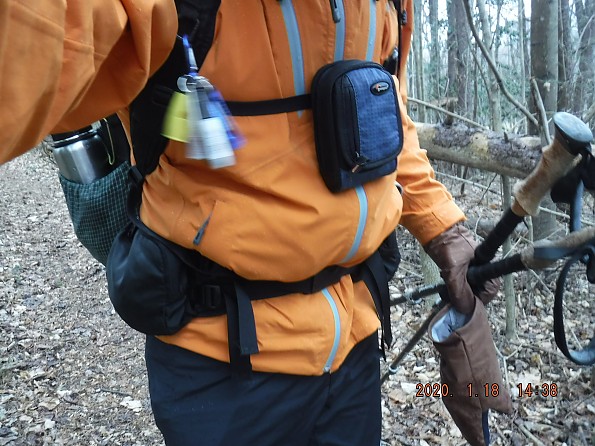 or stabilizer strap unless I wear it low.
or stabilizer strap unless I wear it low.
 The zippers (YKK Aquaguard) seems solid. They have not caught on the material or caused me any problems.
The zippers (YKK Aquaguard) seems solid. They have not caught on the material or caused me any problems.
 There is an internal storm flap behind the zipper if things really get bad. However, please see the section about water resistance for some slight concerns in this area.
There is an internal storm flap behind the zipper if things really get bad. However, please see the section about water resistance for some slight concerns in this area.
As mentioned earlier, the hood drawcord lock is neatly tucked out of the way under the rim but that makes it a little difficult to get a hold of with gloves on. I would prefer a classic lock where the cord emerges.
Style:
This is the worst category for me as I think I went out of style sometime in the '80s, if I was ever in style.
 I think the jacket looks fine but will leave that to others judgement. There are several color options (four for men and four for women) upon checking OR’s site, so take your pick and don’t listen to me.
I think the jacket looks fine but will leave that to others judgement. There are several color options (four for men and four for women) upon checking OR’s site, so take your pick and don’t listen to me.
Personally, orange is my favorite shell color in the event I am heading into hunting territory, or I guess I would also stand out against the snow if I ever had to use my Inreach emergency button. However note that the OR site, at the time of this review, is not showing the orange I have as an option. I hope that changes!
Weight:
The Microgravity is not the lightest option on the market, but is listed at a trim 14.6 ounces. I weigh it in at just over 15 ounces (430 grams). However, if you consider this could replace my rain jacket and wind shirt then I am about at least break-even (Marmot Precip and Patagonia Houdini). It is heavy duty enough that it could replace a light fleece (Rab Nexus) or windshirt/fleece combo (Marmot Ether Driclime) that I carry in varying weather conditions with no real weight penalty. Depending on your current choices, your savings will obviously be different.
Stink Factor:
So far I have not detected a stink in the jacket, and I have sweated a good bit as usual even in higher temps to the mid 70s (F). I have purposely put the Microgravity through its breathability paces by climbing some good hills and turning up the heat inside. Therefore, I have been damp with perspiration numerous times and nothing seems to have "stuck". I still feel like I don't need to wash it after a good bit of use over the last six months.
Construction & Durability:
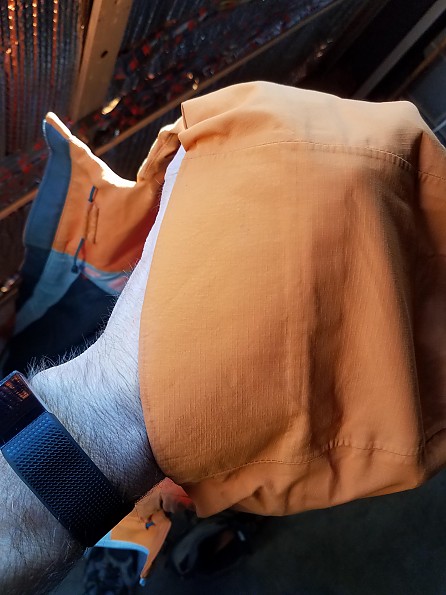 The Microgravity seems very well made. All seams and stitching look solid. The ripstop stretch fabric hasn’t shown any wear in the first few months.
The Microgravity seems very well made. All seams and stitching look solid. The ripstop stretch fabric hasn’t shown any wear in the first few months.
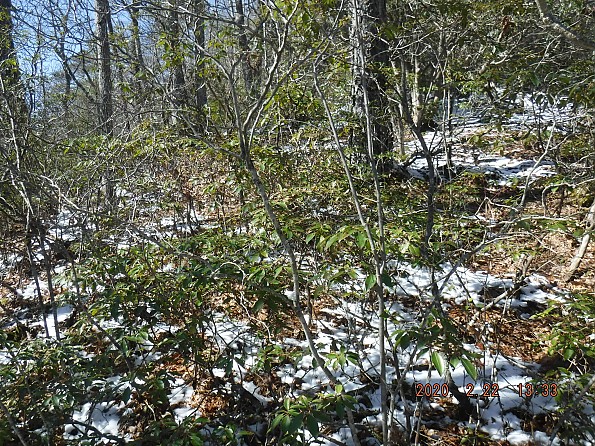 I am comfortable enough with it to wander off trail (I rarely stay on one for an entire day). It seems to handle brush well. I had no fear walking through areas like this...
I am comfortable enough with it to wander off trail (I rarely stay on one for an entire day). It seems to handle brush well. I had no fear walking through areas like this...
After several winter off-trail jaunts, I can see no nicks or excessive dampness at wear spots. The material is so soft and flexible that I did worry that it would wear out fast, but that is not proven by any means yet. Since my initial test, I have taken it to several work sites, so off-trail in non-pristine woods. It has held up well so far. I have not walked through a brier patch with it, but don't plan to! As with any rain jacket, I try to take care of them.
Prior versions of the Ascentshell membrane jackets (i.e. the Interstellar) have had some issues with the DWR wearing off quicker than normal.
 The lack of beading of rain when it's flat doesn't seem to be an indication of DWR wear as it was evident on the first trip and didn't affect waterproofness.
The lack of beading of rain when it's flat doesn't seem to be an indication of DWR wear as it was evident on the first trip and didn't affect waterproofness.
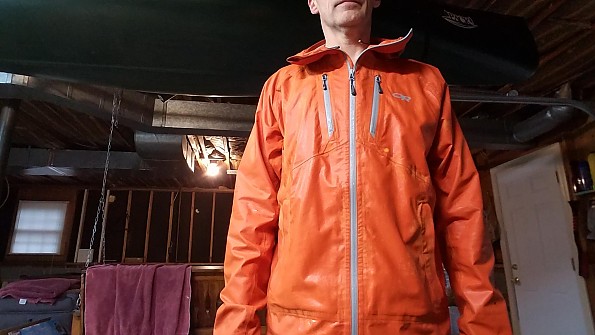
After several months of testing I still see the same lack of beading with no change in performance to date although it does get pretty wet all over (above photo is after a two-hour walk in steady rain).
Care and Maintenance:
OR recommends cleaning any rain gear on a regular basis to keep oil and dirt out of the membranes so they can perform better. They recommend cleaning with a technical wash (ex. Nikwax) and drying on low heat, which helps to reactivate the DWR. I haven’t had to do that yet.
Conditions:
Although I haven’t had the chance to test the Microgravity in multi-day rain backpacking trips, I have had it out in rain, sleet, snow, and wind with temperatures ranging from the low teens to mid-70s degrees F. I took it on five multi-day backpacking trips from January through June 2020. Trips covered 20-30 miles including on and off trail segments, working hard with elevation gain up to 4500 ft or more. One trip was snowy, two others had some rain, and the last two were mild temperatures and windy. My "backyard" testing ground, while in the Southeast US, includes wide open areas in the Virginia Highlands with exposure to the elements and limited cover. Not quite alpine, but it can simulate those conditions at times.
Further testing was limited due to the COVID-19 pandemic hindering backcountry travels in my area, but I made the most of it taking the Microgravity on numerous day hikes, and almost daily walks in all sorts of rain, sleet, snow, wind, and temperatures ranging from around 20 to 70 degrees F. In fact, since I work from home when not traveling, I tended to take a break when a rainstorm comes in and go for a walk!
Best For:
This is definitely a jacket designed, as OR says, for alpine conditions. Working up a sweat in this jacket is not like any other rain gear I have used. The breathability/waterproof/windproof balance is excellent although waterproof/windproof is not absolute due to the excellent air permeability. It would excel in alpine conditions, as windy and snowy days didn’t seem to bother it (or me) at all.
OR is honest in its intent for this jacket (see introduction above) and I think it hits its mark well. Slight deduction in ratings for the hood fit and zipper waterproofing for the most part, on an otherwise excellent jacket. For me as a year-round backpacker (well, at least down to 0°F) I find it just right for those pursuits. I would have no issues carrying this on most of my trips when conditions didn't call for constant rain for days (which unfortunately I haven't been able to test yet due to COVID-19 restricted travel and lack of cooperation from Mother Nature!).
For me as a year-round backpacker (well, at least down to 0°F) I find it just right for those pursuits. I would have no issues carrying this on most of my trips when conditions didn't call for constant rain for days (which unfortunately I haven't been able to test yet due to COVID-19 restricted travel and lack of cooperation from Mother Nature!).
I would continue to extend the Microgravity use into the humid months in the Southeast U.S. Once temperatures are bottoming out around 60 (F) and highs above 80 (F) I would drop it off my kit list until the chilly days return in the fall.
Thanks to Trailspace and Outdoor Research for the opportunity to test the Microgravity AscentShell Jacket.
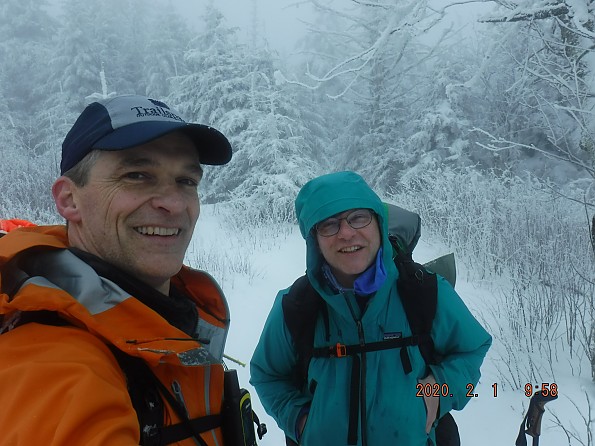 And thanks to fellow Review Corps member Patman, for assisting with some good photos that are difficult for a primarily solo-hiker to take!
And thanks to fellow Review Corps member Patman, for assisting with some good photos that are difficult for a primarily solo-hiker to take!
Background
I have used the Microgravity Jacket from mid-January through June 2020. See the Conditions section above for a description of my activities. Previous rain gear includes super expensive Gore-Tex jackets, 2-2.5 layer cheaper versions, and almost disposable cheapies (i.e. Frogg Toggs). I have not used AscentShell before this or anything quite like it.
Source: received for testing via the Trailspace Review Corps
(Sample for review and testing provided by Outdoor Research)
Exceptional active shell for those in alpine climates and those that use a helmet.
Pros
- Breathability
- Plenty of pockets
- Cuff hook and loop
- Light weight
- No DWR
Cons
- Hood adjustability
- Water sealing on zippers
I purchased the Microgravity direct from OR in the Lime color, which is a cool color. Overall I liked the fit and feel of the jacket and the Ascentshell material. For reference I am 5'7" 165 and ordered a Large for layering underneath, which fit slightly baggy as expected. A medium would have been more fitted but lacked the layering ability.
I asked OR ahead of time about DWR treatments and was told the Ascentshell material is waterproof and there is no DWR treatment to wear off, which I think is good. I tested the jacket in my shower for lengthy amounts of time and while no water came through the material I did find that if the zippers are not fully closed into their little hoods that water will come through. And even when fully closed I still got some water in the lower pockets and a wet hem on the inside. Not a major issue at all but if in extended, all-day rain would wet whatever is under it.
The hood is where I found the biggest issue. It is totally meant to be worm with a helmet. It's huge. The adjustment cords for the face are on the inside of the neck and are an absolute pain to get to. With gloves they would be madness to tighten. The cord in the back to adjust the halo works, but there is so much material that it bunches and I found it uncomfortable. The hood also, even cinched down, doesn't follow your face so when you turn your head (if you're not wearing a helmet) your face turns into the hood, not the hood with your face (the hood was the reason I returned it).
I think the jacket will do its job for its intended use, but I think for non-helmet wearing people, there are some better options.
Since my time with the jacket was short I can't speak to abrasion resistance or long-term durability.
Fit: Roomy and slightly long, but not overly, just right for being active.
Adjustability: Plenty of adjustment points all around which, except for the hood are easy to get to.
Feel: The Ascentshell outer has a soft feel and a soft next-to-skin feel inside.
Function: Pockets are easy to access and large, so it's easy to put plenty of items in all the pockets and get them out. The zippers had pulls and were easy to utilize.
Construction: Appears top notch. No defects noted anywhere.
Overall if you're an alipinist or skier and want a jacket that's breathable and helmet-compatible this is an awesome jacket that's weather resistant, functional, and has some great looks to it.
Background
Only tested at home.
Source: bought it new
Price Paid: $249
Your Review
Where to Buy
You May Like
Specs
| Men's | |
|---|---|
| Price |
MSRP: $249.00 Current Retail: $123.99-$279.00 Historic Range: $94.73-$279.00 Reviewers Paid: $249.00 |
| Weight |
14.6 oz / 414 g |
| Fit |
Trim Fit |
| Fabric |
Ascentshell 3L, 100% nylon 20Dx45D mechanical stretch ripstop with 100% polyester 30D knit backer |
| Women's | |
|---|---|
| Price |
MSRP: $249.00 Current Retail: $69.74-$279.00 Historic Range: $69.74-$279.00 |
| Weight |
11.9 oz / 338 g |
| Fit |
Trim Fit |
| Fabric |
AscentShell 3L, 100% nylon 20Dx45D mechanical stretch ripstop with 100% polyester 30D knit backer |



